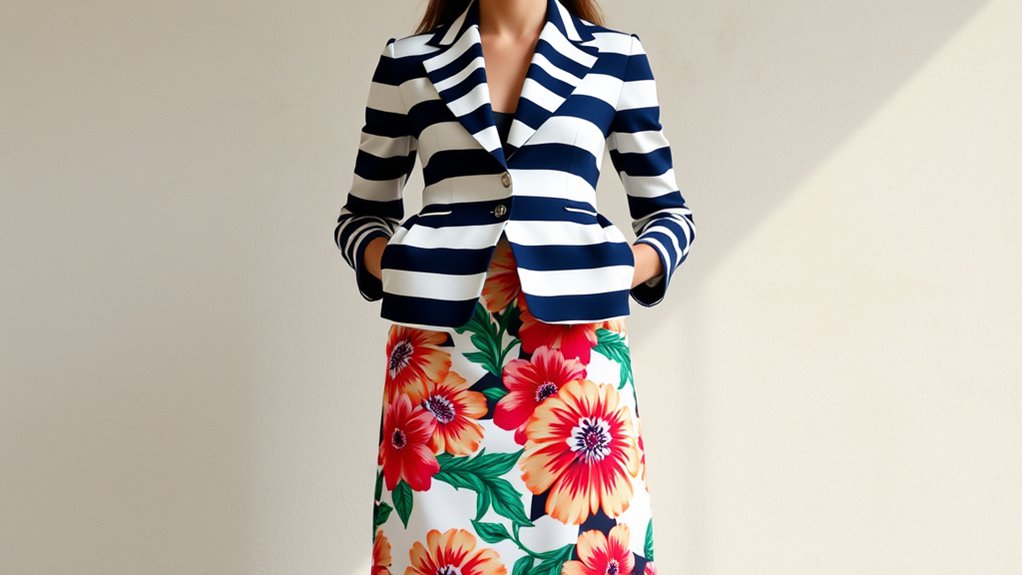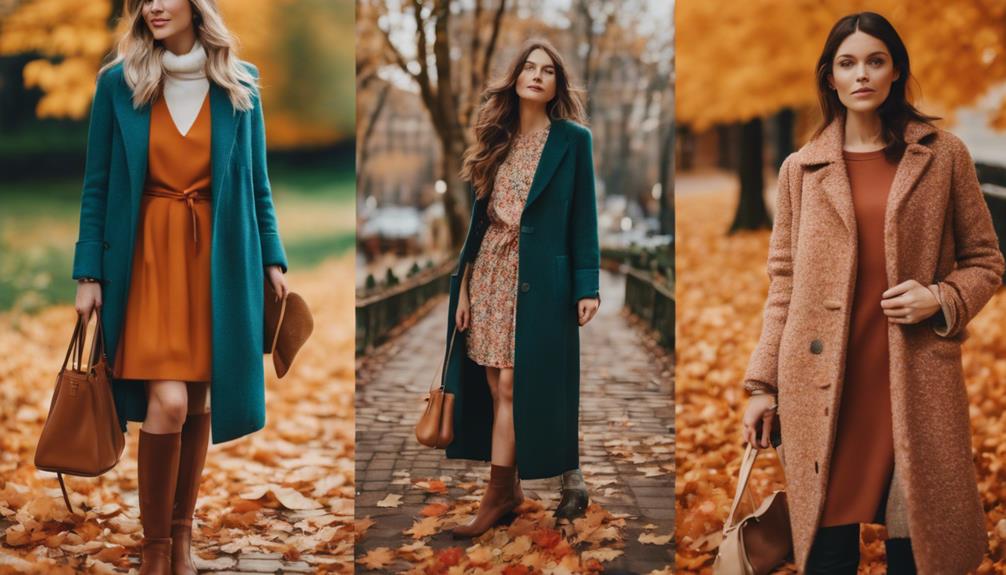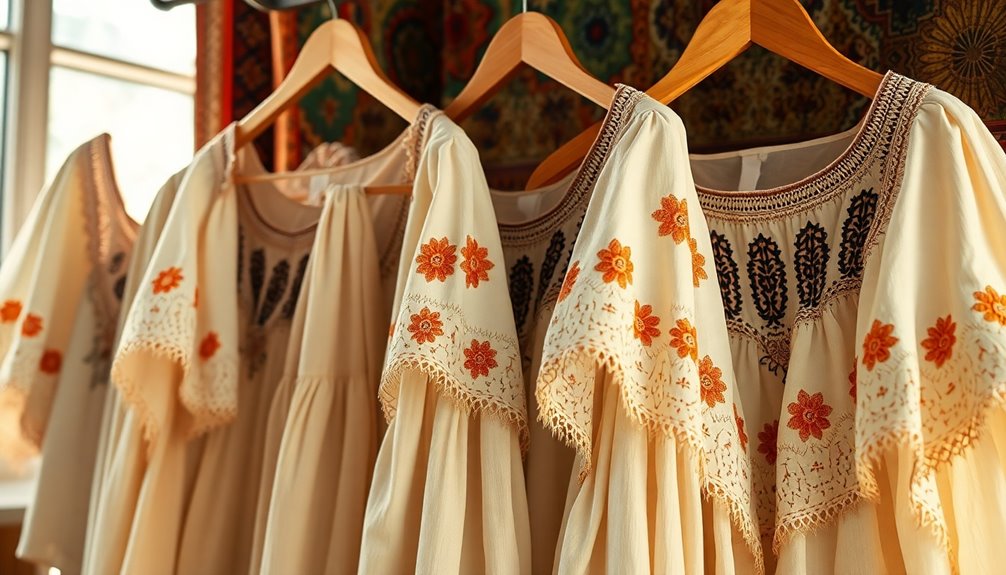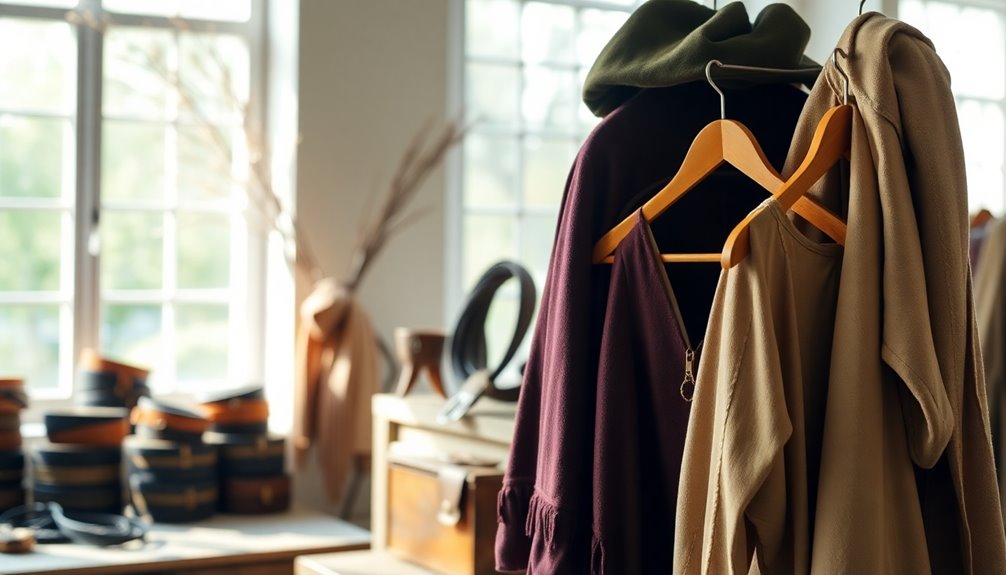To mix and match patterns like a pro, start with classic pairings such as stripes and plaids in neutral tones for balance. Vary pattern scales—combine large with small for visual interest—and choose a cohesive color palette with neutrals and accent hues. Incorporate neutral shades to ground the look, and experiment with contrasting patterns and colors to add excitement. Finish with accessories that complement, and if you keep exploring, you’ll master smart, stylish pattern mixing effortlessly.
Key Takeaways
- Start with a neutral base and incorporate accent colors for cohesion.
- Vary pattern scales—mix large, medium, and small prints for visual interest.
- Balance bold patterns with neutral or solid pieces to prevent overload.
- Use consistent color palettes and repeat neutral tones to unify the look.
- Accessorize thoughtfully with solid colors or subtle metallics to enhance pattern harmony.
Understanding Pattern Scales and Sizes
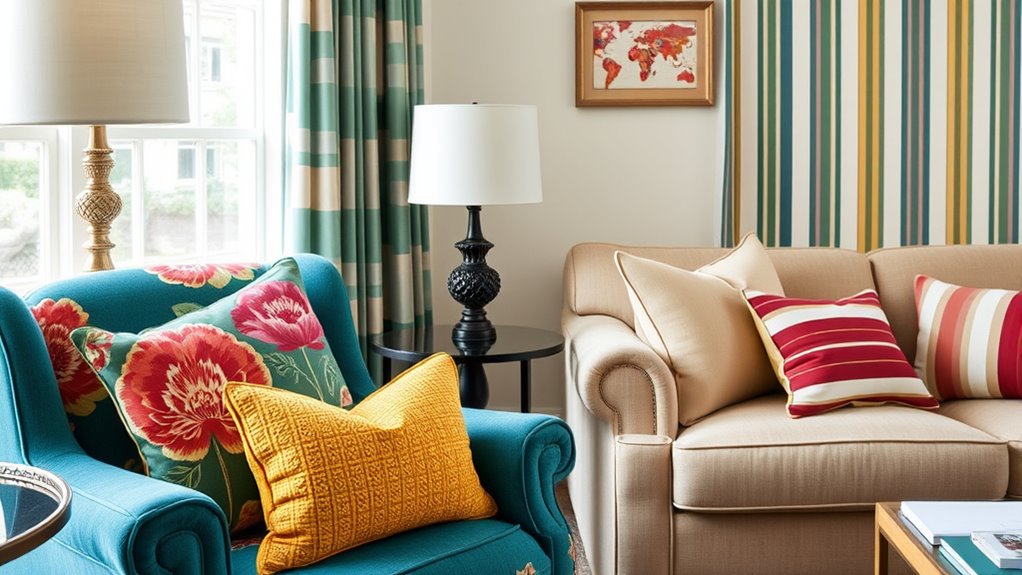
To successfully mix and match patterns, understanding how pattern scales and sizes work is essential. You need to recognize that varying scales create visual interest and prevent patterns from competing. For example, pairing a large floral print with small polka dots balances the overall look. Larger patterns tend to draw attention and should be used sparingly, while smaller patterns can be layered more freely. When mixing patterns, aim for a mix of big, medium, and small sizes to add depth and harmony. Keep in mind that the scale of each pattern impacts how they relate to each other. By paying attention to these differences, you’ll create a cohesive and stylish ensemble that feels intentional and well-balanced. Incorporating principles from the Law of Attraction, such as visualizing your ideal outfit combinations, can also help you develop a more confident and harmonious style. Additionally, understanding how marketing strategies leverage visual elements can inspire your pattern matching to make your outfits more captivating and memorable. Recognizing the importance of pattern balance can help you avoid overwhelming your look with too many competing designs. Practicing mindful visual harmony ensures your outfits are both eye-catching and cohesive, reflecting a well-thought-out approach. Being aware of pattern proportions allows you to better control the visual weight of each element and maintain balance throughout your ensemble.
Choosing a Color Palette for Cohesion
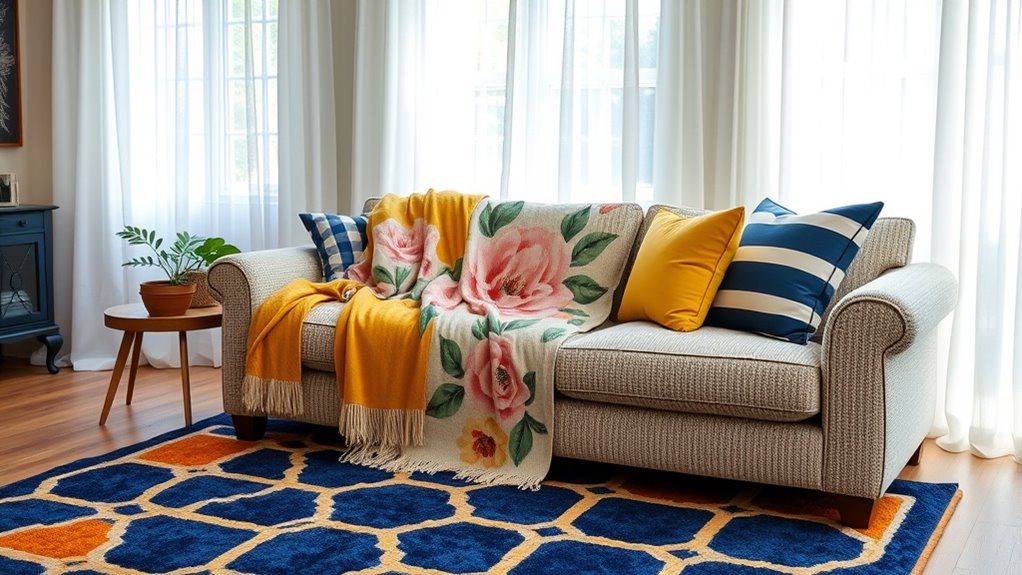
To create a cohesive pattern mix, start by harmonizing your colors with neutral shades that ground the space. Incorporate accent colors to add visual interest without overwhelming your design, and balance bright hues with muted tones to keep everything feeling harmonious. This approach guarantees your pattern choices work together seamlessly.
Harmonize With Neutrals
Harmonizing your patterned pieces with neutral tones creates a balanced and versatile color palette. Neutrals like beige, gray, white, or taupe act as a calming backdrop that allows your patterns to stand out without overwhelming the space. When you incorporate neutral shades, you create cohesion, making it easier to mix different patterns confidently. Neutral tones also add sophistication and flexibility, letting you change your decor or wardrobe easily over time. To achieve harmony, choose one or two neutral colors that complement your patterns and repeat them throughout the design. This consistency ties everything together and prevents the look from feeling chaotic. Additionally, understanding color theory principles can help you select neutrals that harmonize well with your patterns. Recognizing color relationships can further enhance your ability to create visually appealing combinations. For instance, considering complementary colors can help you balance bold patterns with subtle neutrals for a more cohesive look. Incorporating texture variations in your neutral pieces can also add depth and interest to your overall design. Moreover, paying attention to vibrational energy can influence how harmonious your overall pattern mix feels, ensuring your space or wardrobe radiates positive, uplifting vibes. Remember, neutrals aren’t boring—they serve as the foundation for a well-balanced, stylish pattern mix.
Use Accent Colors
Building on the idea of neutral tones, introducing accent colors can elevate your pattern combinations by adding visual interest and depth. Choose one or two bold hues that complement your main palette, and sprinkle them throughout your décor. These pops of color draw the eye and create focal points within your space. To keep things cohesive, pick accent shades that appear in some of your patterns or accessories, tying everything together seamlessly. Consider using accent colors sparingly—on throw pillows, artwork, or small furniture pieces—to avoid overwhelming the space. Remember, the goal is to enhance your patterns without competing with them. Incorporating color harmony principles can further ensure your accent choices work well together. With thoughtfully chosen accent colors, your mix-and-match approach gains harmony and sophistication.
Balance Bright and Muted
Achieving a cohesive look when mixing patterns often depends on balancing bright and muted colors within your palette. This balance prevents your patterns from clashing or overwhelming the space. Start by choosing a few key colors—perhaps a bright blue or red—and then incorporate muted versions of those shades to ground the design. If you use a vivid pattern, offset it with calmer, muted patterns nearby. This contrast highlights your statement pieces without making the overall look chaotic. Remember, the goal is to create visual interest while maintaining cohesion. Striking the right balance between bright and muted ensures your pattern mix feels intentional and polished. Additionally, understanding how to shift gears smoothly on your bike can inspire you to make seamless transitions in your pattern pairing, creating a harmonious overall look. Incorporating color theory principles can further help in selecting harmonious hues that enhance your pattern combinations. Recognizing the use of color palettes is essential for achieving visual harmony in your styling. Using natural elements as inspiration can also help unify diverse patterns and create a more organic, pleasing design.
Starting With Classic and Safe Pairings
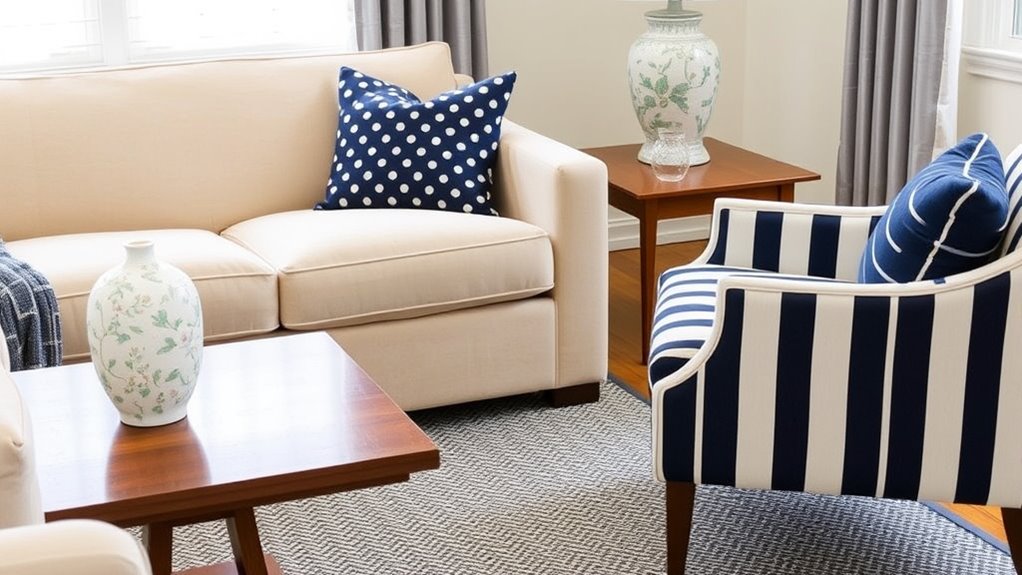
Starting with classic and safe pairings makes pattern mixing feel less intimidating. Combining stripes with polka dots, navy with white, or traditional plaids creates timeless looks that are easy to pull off. These pairings set a solid foundation before experimenting with bolder combinations. Additionally, understanding your core personality traits can help in selecting patterns that reflect your personal style and confidence. When planning your pattern mix, considering home security system costs can help you stay within your budget while creating a stylish space.
Stripes and Polka Dots
Pairing stripes and polka dots can seem intimidating, but sticking to classic combinations makes it simple and stylish. To keep your look balanced, start with a neutral color palette like black and white. Choose one pattern as your statement piece, then complement it with the other in a smaller or more subtle way. For example, wear a striped top with polka dot accessories or vice versa. Keep the sizes of the patterns contrasting—large stripes with small dots—for visual interest. Here are some safe pairing tips:
- Opt for black-and-white stripes with small white polka dots
- Balance bold stripes with delicate, tiny polka dots
- Use one pattern as a base and the other for accessories
- Keep the color scheme cohesive for a polished look
Navy and White Combo
A navy and white combo is a timeless choice that exudes classic sophistication and effortless style. It’s versatile and easy to wear, making it perfect for starting your pattern-mixing journey. You can pair a navy blazer with a white shirt or opt for a navy and white striped dress. To keep things simple, stick with clean lines and minimal accessories. Here’s a quick guide to safe pairings:
| Top/Bottom | Pattern/Color |
|---|---|
| Shirt | White with navy stripes |
| Pants/Skirt | Navy solid |
| Accessories | White or navy accents |
This combo creates a polished look that’s both fresh and timeless. It’s a reliable foundation before exploring bolder patterns or textures. Remember, understanding interior design principles can help you apply similar concepts of balance and harmony to your pattern mixing.
Classic Plaids Pairing
Classic plaid patterns are a timeless choice that effortlessly add texture and visual interest to any outfit. To keep things stylish yet safe, pairing plaid with complementary pieces is key. Stick to neutral or solid colors to balance the busy pattern. For example, wear a plaid shirt with dark jeans or a solid blazer. When mixing plaids, ensure they share a similar color palette for harmony. Keep scale in mind—pair larger plaid patterns with smaller ones to avoid overwhelming your look. Consider these safe pairings:
- Plaid shirt with solid trousers
- Plaid skirt with a plain top
- Blazer with a subtle plaid pattern
- Accessories like scarves or ties in matching tones
Following these tips helps you master classic plaid pairings that look polished and effortless. Additionally, paying attention to prophetic dreams can offer insight into personal style choices and subconscious influences. Incorporating fashion psychology into your styling approach can help you understand how different patterns affect your overall image and confidence. Recognizing how dog breed characteristics can inspire your pattern choices adds a personalized touch to your wardrobe. Being aware of trend cycles can also guide you in choosing patterns that remain timeless rather than fleeting fads. Embracing interior decor trends can also influence your fashion selections, creating a cohesive personal style that reflects current aesthetics.
Incorporating Neutral Tones to Balance Out Patterns
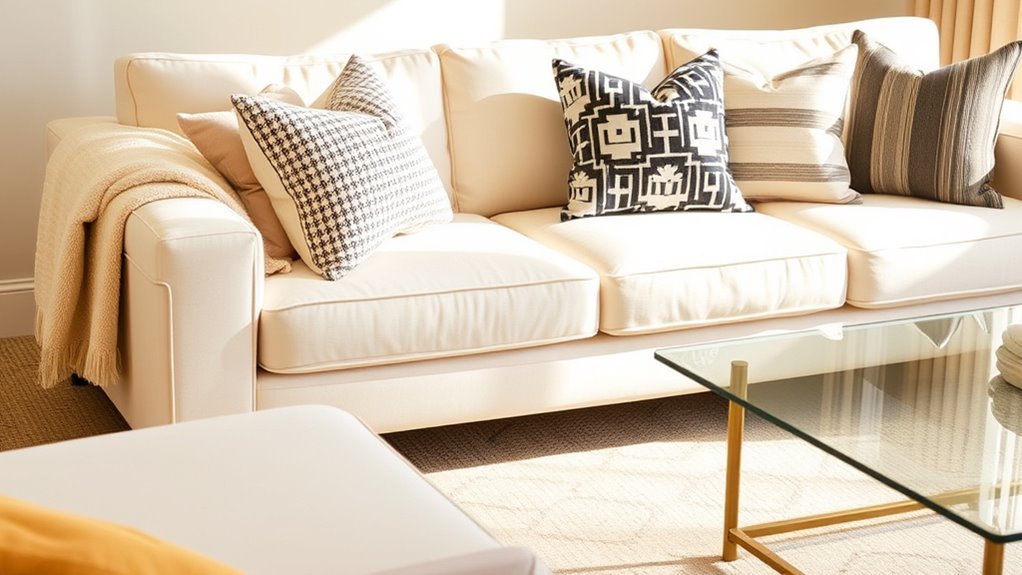
When you incorporate neutral tones into your patterned ensembles, you create a calming visual balance that prevents the overall look from becoming overwhelming. Neutral shades like beige, gray, and white serve as a grounding element, allowing bold patterns to stand out without clashing. They act as a visual rest, making your outfit more cohesive and sophisticated. To enhance this effect, mix textures and fabrics within your neutrals, adding depth. Use the following table to see how neutral tones can complement different patterns:
| Pattern Type | Neutral Color Pairing | Result |
|---|---|---|
| Stripes | Gray or beige | Modern and balanced |
| Floral | White or cream | Soft, elegant contrast |
| Geometric | Taupe or light brown | Sleek, contemporary look |
| Polka Dots | Off-white or stone | Subtle, vintage vibe |
| Checks | Charcoal or tan | Classic, timeless harmony |
In addition, understanding the role of attention in your creative practice can help you select the most effective neutral tones to emphasize your patterns. Recognizing the importance of color theory can further refine your choices for a cohesive design. Moreover, being aware of visual balance can help you craft more harmonious and appealing combinations.
Experimenting With Contrast and Complementary Patterns
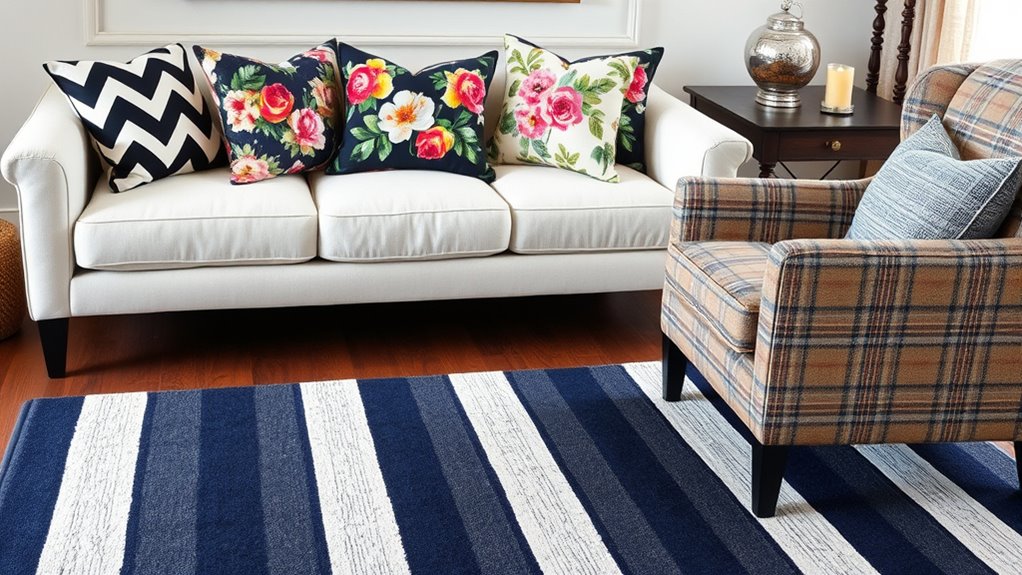
Experimenting with contrast and complementary patterns can elevate your outfit by creating visual interest and dynamic depth. By pairing bold or contrasting patterns, you draw attention and add excitement to your look. Complementary patterns, like florals with stripes, balance each other and create harmony. To master this technique:
- Mix large floral prints with smaller geometric patterns for variety.
- Combine contrasting colors, such as navy and mustard, in different patterns.
- Pair a bold pattern with a subtle one to avoid overwhelming your outfit.
- Use similar color palettes across patterns to create cohesion.
Accessorizing to Enhance Your Pattern Mix
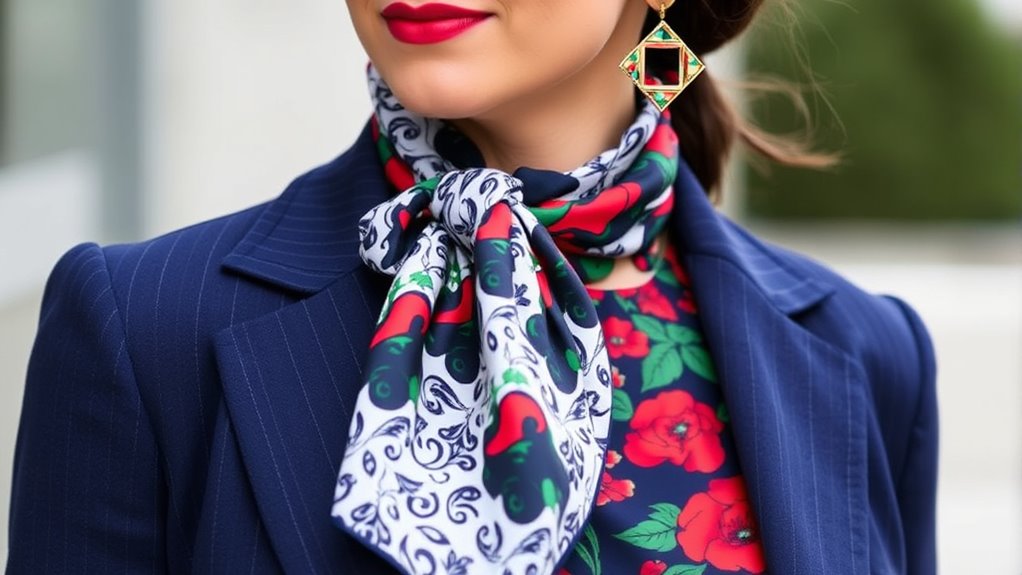
Have you considered how accessories can elevate your pattern mixing? The right jewelry, bags, or scarves can tie your look together and add visual interest. When mixing patterns, choose accessories in solid colors that pick up a hue from your outfit to create harmony. Alternatively, opt for subtle metallics or neutral tones to avoid overwhelming your look. Statement earrings or bold necklaces can draw attention to specific areas and create focal points. A patterned bag or scarf can also add an extra layer of style, but keep it simple to prevent clashing. Remember, accessories should complement your pattern mix, not compete with it. Thoughtful accessorizing enhances your overall look and shows confidence in your fashion choices.
Frequently Asked Questions
How Do I Avoid Pattern Clashes in My Outfit?
To avoid pattern clashes, start by choosing one dominant pattern in your outfit. Keep other patterns smaller or more subtle to create balance. Stick to a cohesive color palette so everything complements well. Mix different textures and scales carefully, and don’t be afraid to break the rules slightly, but always trust your eye. With practice, you’ll develop a sense of which patterns work harmoniously together.
Can Patterns Be Mixed in Small Spaces Effectively?
Perfectly pairing patterns in petite places is totally possible! You just need to plan your palette, balance busy prints with calmer ones, and keep the scale small. Focus on coordinating colors, so patterns complement each other without clashing. You can mix florals with stripes or polka dots with checks, as long as you keep the proportions proportionate. Small spaces are your playground for playful, pretty pattern pairings!
What Patterns Work Best for Professional Settings?
In professional settings, you want patterns that are subtle yet stylish. You can’t go wrong with classic stripes, pinstripes, or gentle florals. Stick to a neutral color palette to keep things polished. Use patterns sparingly—perhaps a striped blouse with a solid blazer or a patterned tie. This approach adds interest without overwhelming, helping you look professional and put-together while showcasing your unique style.
Are There Seasonal Patterns to Consider When Mixing?
Imagine your wardrobe as a canvas—seasonal patterns add depth and story. When mixing, consider cozy plaids and warm florals for fall, while breezy stripes and light polka dots shine in spring and summer. You can blend seasonal patterns thoughtfully, balancing bold with subtle. Think of it as a dance, where each pattern complements the season’s mood, helping you look stylish and season-appropriate without overwhelming your outfit.
How Can I Incorporate Patterns Into Minimalist Decor?
You can incorporate patterns into minimalist decor by choosing subtle, understated prints like thin stripes or small geometric shapes. Use a limited color palette to keep the look cohesive, and balance patterned pieces with solid neutrals. Incorporate patterns through accessories like cushions, throws, or artwork. Keep the overall space simple, allowing the patterns to add visual interest without overwhelming the clean, uncluttered aesthetic you want to maintain.
Conclusion
Mastering pattern mixing boosts your style confidence—did you know that 68% of fashion enthusiasts say experimenting with patterns elevates their wardrobe? By understanding scales, choosing cohesive colors, and balancing neutrals, you can create eye-catching outfits effortlessly. Don’t shy away from contrast or fun accessories; these details make your look unique. With a little practice, you’ll be mixing patterns like a pro in no time. So go ahead, embrace bold combinations and express your personal style confidently!
